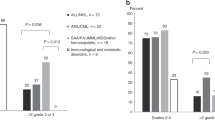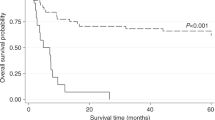Abstract
We report a case of capillary leak syndrome in a 37-year-old female PBPC donor who received G-CSF 900 μg/day for 4 days and underwent leukapheresis. This lady had remained well and stable despite marked leukocytosis during G-CSF treatment, but developed hypotension during leukapheresis, quickly followed by hypoxemia, ascites, pericardial and pleural effusion, shock, edema, neurologic changes and hepatocellular injury. Upon G-CSF withdrawal, dopamine and crystalloid infusion, methylprednisolone treatment and suspension of apheresis, the clinical situation fully reversed. We hypothesize that leukapheresis, in the presence of marked leukocytosis and high doses of G-CSF, may have triggered neutrophil activation and the release of inflammatory mediators, resulting in tissue damage and systemic manifestations of increased capillary permeability. Bone Marrow Transplantation (2001) 28, 311–312.
This is a preview of subscription content, access via your institution
Access options
Subscribe to this journal
Receive 12 print issues and online access
$259.00 per year
only $21.58 per issue
Buy this article
- Purchase on Springer Link
- Instant access to full article PDF
Prices may be subject to local taxes which are calculated during checkout


Similar content being viewed by others
References
Cahill RA, Spitzer TR, Mazumder A . Marrow engraftment and clinical manifestations of capillary leak syndrome Bone Marrow Transplant 1996 18: 177–184
Busmanis IA, Beaty AE, Basser RL . Isolated pleural effusion with hematopoietic cells of mixed lineage in a patient receiving granulocyte-colony-stimulating factor after high-dose chemotherapy Diagn Cytopathol 1998 18: 204–207
Oeda E, Shinohara K, Kamei S et al. Capillary leak syndrome likely the result of granulocyte colony-stimulating factor after high-dose chemotherapy Intern Med 1994 33: 115–119
Hierholzer C, Kelly E, Tsukada K et al. Hemorrhagic shock induces G-CSF expression in bronchial epithelium Am J Physiol 1997 273: L1058–L1064
Hierholzer C, Kelly E, Lyons V et al. G-CSF instillation into rat lungs mediates neutrophil recruitment, pulmonary edema and hypoxia J Leukoc Biol 1998 63: 169–174
Iijima S, Tsuji T, Sugita M et al. Leukocyte activity and occurrence of tissue injury by G-CSF Nippon Sanka Fujinka Gakkai Zasshi 1993 45: 213–219
Kitamura S, Kinouchi K, Fukumitsu K et al. A risk of pulmonary edema associated with G-CSF pretreatment Masui 1997 46: 946–950
Cavallaro AM, Lilleby K, Majolino I et al. Three- to six-year follow-up of normal donors who received recombinant human granulocyte colony-stimulating factor Bone Marrow Transplant 2000 25: 85–89
Author information
Authors and Affiliations
Rights and permissions
About this article
Cite this article
de Azevedo, A., Goldberg Tabak, D. Life-threatening capillary leak syndrome after G-CSF mobilization and collection of peripheral blood progenitor cells for allogeneic transplantation. Bone Marrow Transplant 28, 311–312 (2001). https://doi.org/10.1038/sj.bmt.1703138
Received:
Accepted:
Published:
Issue Date:
DOI: https://doi.org/10.1038/sj.bmt.1703138
Keywords
This article is cited by
-
Systemic capillary leak syndrome following granulocyte colony-stimulating factor therapy in a T-lymphoblastic leukemia/lymphoma patient: a case report
memo - Magazine of European Medical Oncology (2022)
-
Pleurotoxic Drugs—an Update: Someone Else to Blame?
Current Pulmonology Reports (2019)
-
PBSC collection from family donors in Japan: a prospective survey
Bone Marrow Transplantation (2014)
-
PBSC mobilization in newly diagnosed patients with POEMS syndrome: outcomes and prognostic factors
Bone Marrow Transplantation (2013)
-
Granulocyte colony-stimulating factor-induced capillary leak syndrome confirmed by extravascular lung water measurements
Annals of Hematology (2005)



